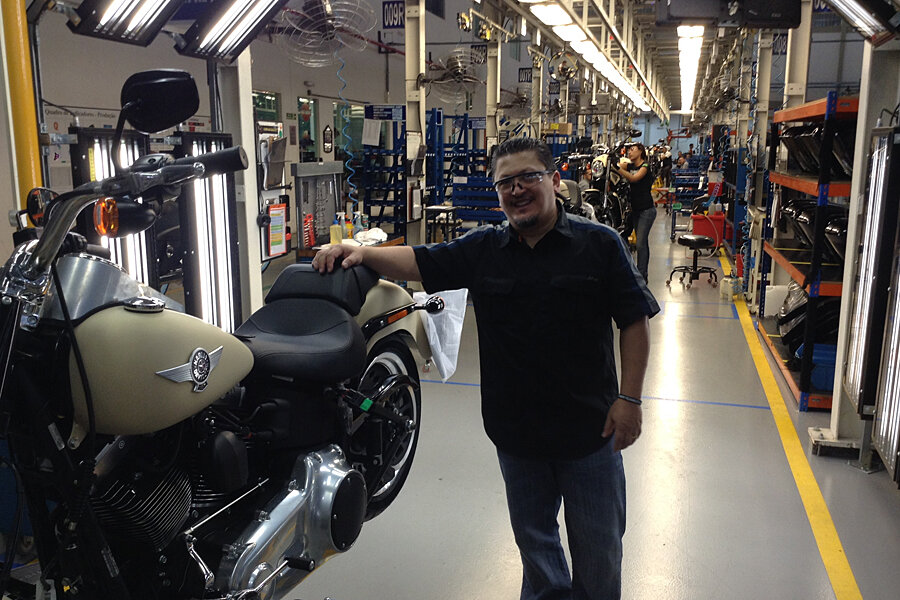Is Amazon industrial hub the latest 'endangered species' in Brazil?
Loading...
| Manaus, Brazil
Every 11.5 minutes, a Harley-Davidson motorcycle is built in the middle of the Amazon.
Power drills hang like jungle vines above work stations at the factory here, and there's an everpresent buzz as workers bolt engines into black steel bike frames and install cranks and shocks and shiny chrome parts as the bikes move along the assembly line. At the end of the line, employees pack finished motorcycles in brown cardboard boxes and ship them 900-miles down the Amazon River for distribution in the nation’s more populous southern cities.
The factory, which opened in 1998 and was the company’s first plant outside the United States, epitomizes the Brazilian government’s use of tax breaks to lure investors to this sleepy jungle port. Since the free trade zone was created in 1967, some 600 national and international manufacturing outfits from Samsung to Coca-Cola to Siemens have moved in.
But some fear Manaus' success story could soon crash to a halt. As Brazil’s Congress debates whether its special tax status – including an 88 percent reduction on import taxes and a 75 percent reduction on federal income tax – should be extended beyond 2023, local officials warn that without it, companies would likely shutter and relocate closer to São Paulo or Rio. That could lead to the loss of 150,000 local jobs, which employ nearly a quarter of the city’s residents.
“If we didn’t have these tax incentives, to import from the United States would cost much more,” Harley-Davidson General Manager Celso Ganeko says.
It's a familiar story: Manaus first emerged in the late 1800s as the world’s primary source of rubber, but crumbled in the early 20th century when Asian producers took over. And the rainforest figures into the current debate on tax incentives: Authorities defend the zone as a way to fight deforestation by offering alternative employment to loggers, ranchers, and farmers.
“The Manaus free trade zone is the only economic development model that we have here in the state of Amazonas,” says Airton Claudino, state secretary of planning and economic development. “It’s the base of economic activity here … and what sustains this model is the tax incentives that are given to the companies.”
Despite the logistical challenges of shipping goods hundreds of miles up and down the Amazon River, the industry base here continues to grow. This month the free trade zone’s oversight body approved 41 projects amounting to $300 million in new investment, including for the companies Canon and Sony. Harley-Davidson has more than tripled the size of its original factory to 100,000 sq ft and boosted annual production to 8,000 motorcycles from just 100 in 1998.
'Not just producing'
The military government created the tax policy in Manaus in the 1960s as a strategy to populate and defend this vast region bordering Venezuela, Colombia, and Peru. The tax benefits were initially scheduled to end in 1997 but have already been extended twice to 2013 and 2023. President Dilma Rousseff has come out in support of another 50-year extension. The proposal is under debate now in Brazil's lower house, which voted in favor of the broad outline in mid-March. Next, the Senate will perform a similar two-step approval process.
Last year the hundreds of foreign and Brazilian manufacturers here generated sales of $38.5 billion (about equivalent to the gross domestic product in Panama). But, “by working here in Amazonas,” Mr. Claudino says, “you’re not just producing you’re protecting the jungle.”
More than half the state’s 3.8 million people live in Manaus, and the job opportunities have helped contain human activity and conserve 98 percent of state forest, says Claudino. In the decade leading up to 2012, the free trade zone doubled employment to 120,000 while contributing to a decline in total state deforestation by 60 percent to 646 sq km, Claudino says.
But environmentalists aren't sold on the benefits, says Philip Fearnside of the National Institute for Research in the Amazon. He says the argument that the employment opportunities keep locals out of logging and cattle trades is oversold: Those drawn to Manaus aren't coming from the parts of the rainforest most under threat of deforestation.
And officials from neighboring states say the tax zone benefits are spread unequally, with other northern states asking for a percentage of the tax revenues and some southern states vying for their own tax breaks.
Moreover, operating an industrial hub in the middle of the Amazon presents logistical challenges that are clear at the Harley-Davidson factory. Rosenildo Belem Dutra, who has worked at the plant for more than a decade, leads a team in assembling engine kits that were first manufactured in Wisconsin. To reach the factory floor in Manaus, the parts are transported by truck to the US east coast, loaded onto a boat south to the Panama Canal, and then loaded onto a smaller boat that travels around the top of South America to the mouth of the Amazon River. Finally the parts travel upriver to the Port of Manaus and overland by truck to the plant. In total, this shipping process takes 46 days.
Despite the lengthy journey, Celso says its worth it.
"We're proud to have a factory in the middle of the jungle."








